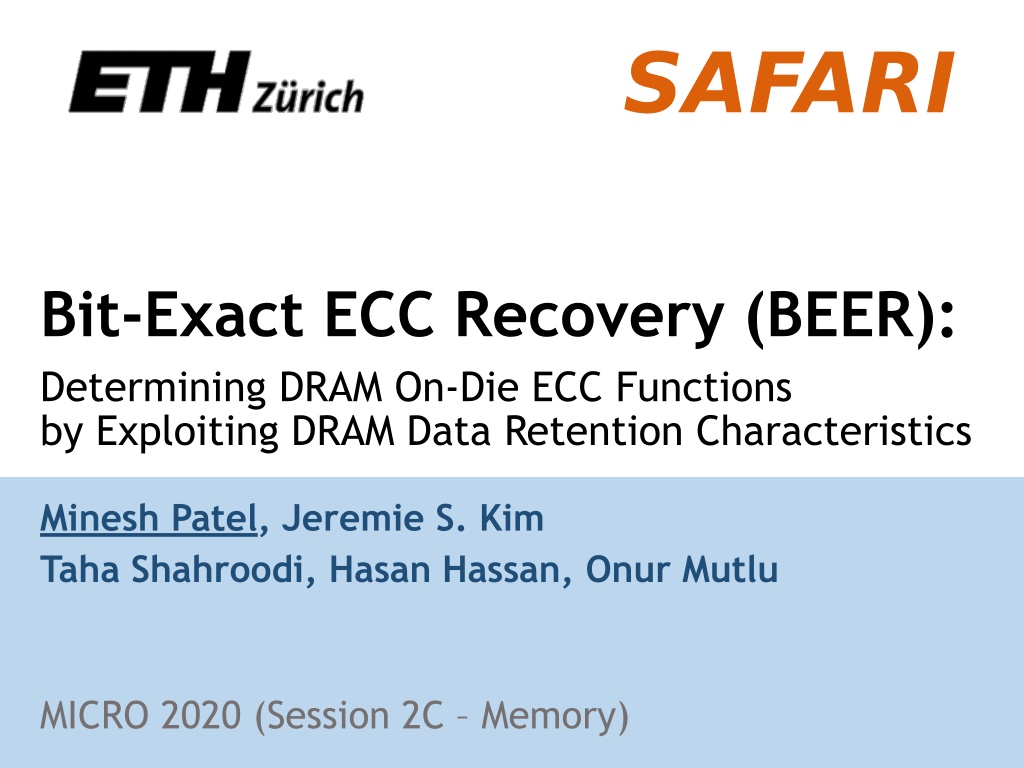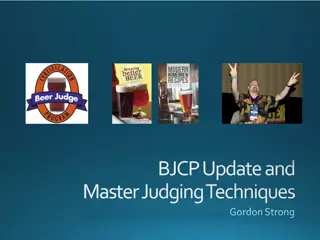Understanding the Impact of On-Die ECC on DRAM Error Characteristics
The BEER project explores how on-die ECC complicates DRAM reliability studies by concealing error characteristics. It aims to uncover the unique ECC function of DRAM chips and infer error locations in error-prone cells. The study highlights the challenges in identifying and correcting bit flips obfuscated by on-die ECC, with implications for DRAM testing and error characterization.
Download Presentation

Please find below an Image/Link to download the presentation.
The content on the website is provided AS IS for your information and personal use only. It may not be sold, licensed, or shared on other websites without obtaining consent from the author. Download presentation by click this link. If you encounter any issues during the download, it is possible that the publisher has removed the file from their server.
E N D
Presentation Transcript
Bit-Exact ECC Recovery (BEER): Determining DRAM On-Die ECC Functions by Exploiting DRAM Data Retention Characteristics Minesh Patel, Jeremie S. Kim Taha Shahroodi, Hasan Hassan, Onur Mutlu MICRO 2020 (Session 2C Memory)
PROBLEM DRAM on-die ECC complicates reliability studies by obfuscating DRAM error characteristics GOAL Understand exactlyhow on-die ECC obfuscates errors CONTRIBUTIONS 1. BEER: Determines a DRAM chip s unique on-die ECC function (i.e., its parity-check matrix) 2. BEEP: Infers raw bit error locations of error-prone cells using only the observed uncorrectable errors EVALUATIONS 1. Experiment: Demonstration using 80 LPDDR4 DRAM chips 2. Simulation: Correctness and practicality for >100,000 representative on-die ECC codes (4-247b ECC words) 2
Research Scientists Error-Characterization System Architects Design Error Mitigations Test Engineers Third-Party Testing Need to understand a DRAM chip s reliability characteristics Inter-chip variation? Temperature dependence? Weak cell locations? Statistical error properties? Aggregate failure rates? Minimum operating timings? 3
DRAM Testing and Error Characterization On-die ECC Study observed bit flips Unknown & Proprietary Study observed bit flips Bit flips obfuscated by on-die ECC No feedback to CPU upon error correction 4
DRAM Testing and Error Characterization On-die ECC On-die ECC complicates reliability studies by unpredictably obfuscating raw bit errors Study observed bit flips Unknown & Proprietary Study observed bit flips Bit flips obfuscated by on-die ECC No feedback to CPU upon error correction 5
Our goal: Determine exactlyhow on-die ECC obfuscates errors (i.e., its parity-check matrix) DRAM Chip I/O ECC Logic Data Store Reveals how on-die ECC scrambles errors (BEER) Allows inferring raw bit error locations (BEEP) 6
Key idea: disabling DRAM refresh induces data-retention errors only in CHARGED cells Data-Retention Error CHARGED DISCHARGED X 7
Key idea: disabling DRAM refresh induces data-retention errors only in CHARGED cells Data-Retention Error We can selectively induce errors by controlling bit-flip directions CHARGED DISCHARGED X 8
BEER Testing Methodology Induce uncorrectable data-retention errors by disabling DRAM refresh operations 1 Identify which uncorrectable errors are and are not possible 2 Solve for the parity-check matrix using a SAT solver 3 9
Induce uncorrectable data-retention errors by disabling DRAM refresh operations 1 Carefully Chosen Test Patterns Uncorrectable Errors Observed Disable DRAM Refresh E E 0 0 1 0 0 0 E 0 0 E - E - - 0 E E 0 0 1 0 0 0 0 E 0 - E - E Only some bits are CHARGED Errors only occur in specific bits 10
Identify which uncorrectable errors are and are not possible 2 Test Patterns Possible Uncorrectable Errors 1 0 0 0 E - E - 0 1 0 0 E E - - 0 0 1 0 - E E E 0 0 0 1 E E - E Different for different ECC Functions 11
Solve for the parity-check matrix using a SAT solver 3 Observed errors 1 0 0 0 E - E - 0 1 0 0 E E - - Parity-Check Matrix ....... ....... ....... 0 0 1 0 - E E E 0 0 0 1 E E - E SAT Solver Properties of a Hamming code ....... ....... ....... ? = 12
BEER Summary BEER determines the parity-check matrix without: (1) hardware support or tools (2) prior knowledge about on-die ECC (3) access to ECC metadata (e.g., syndromes) Open-source C++ tool on GitHub https://github.com/CMU-SAFARI/BEER 13
Experimental demonstration 80 LPDDR4 DRAM chips (3 major manufacturers) Two-Part Evaluation Simulated correctness and practicality Over 100,000 representative ECC codes of varying word lengths (4 247 bits) 14
1. Different manufacturers appear to use different parity-check matrices Experimental demonstration 80 LPDDR4 DRAM chips (3 major manufacturers) 2. Chips of the same model appear to use identical parity-check matrices Two-Part Evaluation 1. BEER works for all simulated test cases Simulated correctness and practicality Over 100,000 representative ECC codes of varying word lengths (4 247 bits) runtime and memory usage 2. BEER is practical in both 15
Crafting worst-case test patterns Studying raw bit error properties Profiling for error-prone physical cells Root-cause failure analysis BEER Use Cases Designing Systems Improving on-die ECC System-level error-mitigation mechanisms 16
Bit-Exact ECC Recovery (BEER): Determining DRAM On-Die ECC Functions by Exploiting DRAM Data Retention Characteristics Minesh Patel, Jeremie S. Kim Taha Shahroodi, Hasan Hassan, Onur Mutlu MICRO 2020 (Session 2C Memory)























